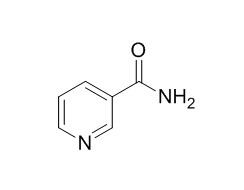Nicotinamide
Nicotinamide is a form of vitamin B3 that plays essential roles in cell physiology through facilitating NAD+ redox homeostasis and providing NAD+ as a substrate to a class of enzymes that catalyze non-redox reactions. Nicotinamide is an inhibitor of SIRT1, it has insulinotropic action, it can induce differentiation and maturation of human fetal pancreatic islet cells.
Nicotinamide may represent a safe treatment for Alzheimer's disease and other tauopathies, and that phosphorylation of tau at Thr231 may regulate tau stability.
Inquire / Order:
manager@chemfaces.com
Technical Inquiries:
service@chemfaces.com
Tel:
+86-27-84237783
Fax:
+86-27-84254680
Address:
1 Building, No. 83, CheCheng Rd., Wuhan Economic and Technological Development Zone, Wuhan, Hubei 430056, PRC
Providing storage is as stated on the product vial and the vial is kept tightly sealed, the product can be stored for up to
24 months(2-8C).
Wherever possible, you should prepare and use solutions on the same day. However, if you need to make up stock solutions in advance, we recommend that you store the solution as aliquots in tightly sealed vials at -20C. Generally, these will be useable for up to two weeks. Before use, and prior to opening the vial we recommend that you allow your product to equilibrate to room temperature for at least 1 hour.
Need more advice on solubility, usage and handling? Please email to: service@chemfaces.com
The packaging of the product may have turned upside down during transportation, resulting in the natural compounds adhering to the neck or cap of the vial. take the vial out of its packaging and gently shake to let the compounds fall to the bottom of the vial. for liquid products, centrifuge at 200-500 RPM to gather the liquid at the bottom of the vial. try to avoid loss or contamination during handling.
Chulalongkorn University2024, 4761190
Plant Direct.2021, 5(12):e372.
Front Microbiol.2022, 13:835463.
Molecules.2023, 28(3):958.
Analytical Methods2018, 10(27)
Foods.2021, 10(11):2754.
Front Nutr.2023, 10:1168095.
Biomolecules.2024, 14(10):1257.
Biol Pharm Bull.2018, 41(11):1685-1693
Int J Cosmet Sci.2022, doi:10.1111/ics.12827.
Related and Featured Products
J Neurosci. 2008 Nov 5;28(45):11500-10.
Nicotinamide restores cognition in Alzheimer's disease transgenic mice via a mechanism involving sirtuin inhibition and selective reduction of Thr231-phosphotau.[Pubmed:
18987186 ]
Memory loss is the signature feature of Alzheimer's disease, and therapies that prevent or delay its onset are urgently needed. Effective preventive strategies likely offer the greatest and most widespread benefits. Histone deacetylase (HDAC) inhibitors increase histone acetylation and enhance memory and synaptic plasticity.
METHODS AND RESULTS:
We evaluated the efficacy of Nicotinamide, a competitive inhibitor of the sirtuins or class III NAD(+)-dependent HDACs in 3xTg-AD mice, and found that it restored cognitive deficits associated with pathology. Nicotinamide selectively reduces a specific phospho-species of tau (Thr231) that is associated with microtubule depolymerization, in a manner similar to inhibition of SirT1. Nicotinamide also dramatically increased acetylated alpha-tubulin, a primary substrate of SirT2, and MAP2c, both of which are linked to increased microtubule stability. Reduced phosphoThr231-tau was related to a reduction of monoubiquitin-conjugated tau, suggesting that this posttranslationally modified form of tau may be rapidly degraded. Overexpression of a Thr231-phospho-mimic tau in vitro increased clearance and decreased accumulation of tau compared with wild-type tau.
CONCLUSIONS:
These preclinical findings suggest that oral Nicotinamide may represent a safe treatment for AD and other tauopathies, and that phosphorylation of tau at Thr231 may regulate tau stability.
Nature. 2003 May 8;423(6936):181-5.
Nicotinamide and PNC1 govern lifespan extension by calorie restriction in Saccharomyces cerevisiae.[Pubmed:
12736687]
Calorie restriction extends lifespan in a broad range of organisms, from yeasts to mammals. Numerous hypotheses have been proposed to explain this phenomenon, including decreased oxidative damage and altered energy metabolism.
CONCLUSIONS:
In Saccharomyces cerevisiae, lifespan extension by calorie restriction requires the NAD+-dependent histone deacetylase, Sir2 (ref. 1). We have recently shown that Sir2 and its closest human homologue SIRT1, a p53 deacetylase, are strongly inhibited by the vitamin B3 precursor Nicotinamide. Here we show that increased expression of PNC1 (pyrazinamidase/nicotinamidase 1), which encodes an enzyme that deaminates Nicotinamide, is both necessary and sufficient for lifespan extension by calorie restriction and low-intensity stress. We also identify PNC1 as a longevity gene that is responsive to all stimuli that extend lifespan. We provide evidence that Nicotinamide depletion is sufficient to activate Sir2 and that this is the mechanism by which PNC1 regulates longevity.
CONCLUSIONS:
We conclude that yeast lifespan extension by calorie restriction is the consequence of an active cellular response to a low-intensity stress and speculate that Nicotinamide might regulate critical cellular processes in higher organisms.
J Clin Invest. 1993 Sep;92(3):1459-66.
Nicotinamide is a potent inducer of endocrine differentiation in cultured human fetal pancreatic cells.[Pubmed:
8104197]
The effects of Nicotinamide (NIC) on human fetal and adult endocrine pancreatic cells were studied in tissue culture.
METHODS AND RESULTS:
Treatment of the fetal cells with 10 mM NIC resulted in a twofold increase in DNA content and a threefold increase in insulin content. This was associated with the development of beta cell outgrowths from undifferentiated epithelial cell clusters and an increase in the expression of the insulin, glucagon, and somatostatin genes. DNA synthesis was stimulated only in the undifferentiated cells. Half-maximal doses for the insulinotropic and mitogenic effects of NIC were 5-10 and 1-2 mM, respectively. Islet-like cell clusters cultured with NIC responded to glucose stimulation with a biphasic increase in insulin release (fourfold peak), whereas control cells were unresponsive to glucose. Both control and NIC-treated cells developed into functional islet tissue after transplantation into athymic nude mice. As compared with adult islets, the insulinotropic action of NIC could only be demonstrated in the fetal cells.
CONCLUSIONS:
Our results indicate that NIC induces differentiation and maturation of human fetal pancreatic islet cells. This model should be useful for the study of molecular mechanisms involved in beta cell development.
Biochem. Biophys. Res. Commun., 1963, 11(1): 39-43.
Nicotinamide mononucleotide activation of new DNA-dependent polyadenylic acid synthesizing nuclear enzyme.[Reference:
WebLink]
Nicotinamide mononucleotide activation of new DNA-dependent polyadenylic acid synthesizing nuclear enzyme.



